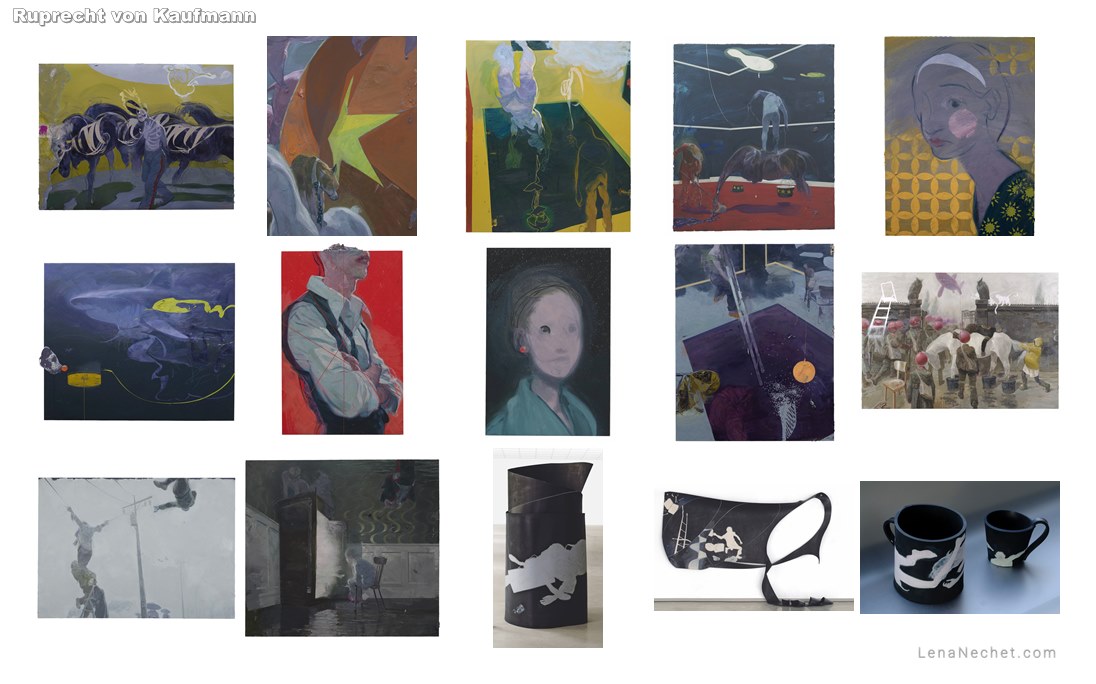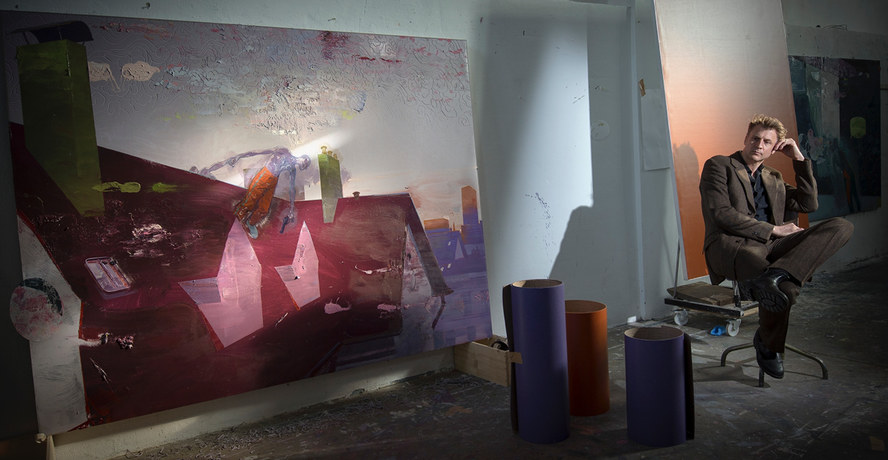Ruprecht von Kaufmann is a German fine art painter who studied and worked in Los Angeles for several years.
His paintings are usually large enough to cover a wall, and by creating them, Ruprecht aims not only to submerge the viewer into composition, but also wants to give himself the freedom to move freely by creating the artwork, making large dancing gestures. According to the artist himself, he interacts with the initial idea for each creation during transferring small gouache painting to the large oil canvases, and develops it on the go. Sometimes he changes the composition to match the change in perception from the larger surface.
Often, Ruprecht depicts animals, which I found reminicent of Franz Marc, one of my favorite artists. I was quite intrigued by the imagery of animal suffering in Ruprecht's paintings of recent years, and only after a long research was able to discover that he uses them as cultural symbols. The traditionally regarded dual split of human nature into animalistic, or instinctual, and rational parts is often the core of the presented conflict in the “plots” of his narrative works. Another significant point of interest for him is stages of life and intergenerational communication.
Ruprecht von Kaufmann likes to tell visual stories and to depict the world around him. He matured as an artist in a culture of disregard to representational qualities of modern visual art, in which telling stories through painting was considered as lacking potential. Getting in touch with other representational artists helped him to establish his own representational style just by the fact that there was some interest to such compositions in fine art circles.
When Ruprecht returned to Germany, he went through a significant change in his art, as he stated in his video presentation. He also needed to start anew as a practicing artist due to lack of connections and no recognition.
First thing one can notice looking at his paintings, is that his work was influenced by Lucian Freud, and Ruprecht himself names him as his favorite artist. It is especially noticeable in his brushwork, his use of gray, in subtlety of color, and in photographically wide angles of view in compositions. Sometimes Ruprecht layers primary colors to the point they cancel each other almost entirely, leaving just a hint of a hue on a subject. He often mixes oils and wax or acrylics to achieve certain reflective qualities of the paint film.
Another obvious influence would be Francis Bacon, in my opinion - in nebulous treatment of heads and disassembling body parts, although I have noticed similarities, surprisingly, with Marc Chagall as well - especially in poses of the figures and in pseudo-naive juxtaposition of the characters or environments.
Rupert’s paintings seem to me to have also strong surrealistic properties and some feel of collage. He had some fun with installation art, and I find his treating resin with black and white acrylics especially notable. His painted caps have zen-quality to them, and I sometimes find a humorous note in his view at reality.
Ruprecht von Kaufmann seem to have a deep gentle soul, and it is exciting to look forward to his future creations.
His work that touched me to tears: Fabel, 2014
His work that I see as one of the most innovative paintings of our time: Zuschauer, 2014

Official Website
From his Bio
BORN on 02.28.1974 in Munich
1995 - 1997 BFA in Illustration amt Art Center College of Design, Los Angeles
1997 - 2003 lives and works in Los Angeles and New York
2003 + lives and works in Berlin
2008 – 2009 teaches color-theory and drawing at the Universität der Künste, Berlin
2010 teaches drawing and painting at the Hochschule für Angewandte Wissenschaften, Hamburg
2012 – 2014 Professor for anatomy and drawing at the Hochschule für Grafik und Buchkunst, Leipzig
Quotes from interviews:
“Painting is like life. It evolves constantly, you never stop learning, and I never feel entirely safe in front of the easel. There are days of elation in the studio, but there inevitably are the days of dismal failure that put you back into your place. The concept of style seems very self defeating to me: it’s essentially your own censor telling you what you can or can not do. It’s a form of self censorship at best or an expression of laziness at worst. I allow myself reckless experiments every now and then and that sometimes leads to some rather different work. Of course, from a commercial point of view that is NOT a clever move.”
“I used to start on the canvas pretty much straight away, with just a rough drawing for guidance, but found that this method isn’t ideal for me. These days I do thumbnails and sketches and a pretty tight gouache drawing before I start on the paintings. Only when I feel the guache is exciting enough to proceed do I move to the canvas. ”
“Besides, often ideas become more clear while I am working on them, and sometimes the idea will change as it evolves on the canvas. That is also a reason why I don’t use models or photos as reference.”
“This experience of being an alien, of being confronted with a drastically different world view changed me for ever and has been one of the major influences on my work.”
“There are two things I want my paintings to do: I want to build an immediate and direct emotional connection with my audience. So I look for the kind of experiences that are deeply personal to me, so I can ‘talk’ about them honestly, and experiences that are at the same time universal.”
“For me there is no real difference between abstraction and figuration. Any figurative painting has to work just as a painting, following the same ‘rules’ as an abstract work.”
“I have been less and less interested in depicting a great deal of meticulous detail, but rather strive to keep the painting sketch-like and fluent. As if it just happened like that. That has brought me from developing forms slowly in layers over weeks and weeks, to instead working them out with few rough brushstrokes.”


